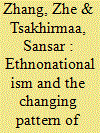|
|
|
Sort Order |
|
|
|
Items / Page
|
|
|
|
|
|
|
| Srl | Item |
| 1 |
ID:
187929


|
|
|
|
|
| Summary/Abstract |
This article proposes an analytical framework to address why implemented autonomy outcomes may differ across ethnically-defined autonomous regions in China. The framework consists of a structural explanatory variable, inter-ethnic boundary-making processes, and an agential intervening variable, titular elites’ representation in the ethno-regional state. It is applied to a synchronic comparison of four ethno-regions with differing autonomy outcomes for 2010–2015, Xinjiang, Tibet, Inner Mongolia, Ningxia. Titular elites’ representation in the ethno-regional state is used as a proxy for titular elites’ bargaining capacity with the central state. This article argues that an ‘integration-distinction balance,’ or rather, higher inter-ethnic integration combined with robust consciousness of inter-ethnic distinction, can contribute to titular elites’ representation in the ethno-regional state, which can lead to greater autonomy outcome for the ethno-region.
|
|
|
|
|
|
|
|
|
|
|
|
|
|
|
|
| 2 |
ID:
170184


|
|
|
|
|
| Summary/Abstract |
Based upon interviews and ethnographic fieldwork conducted in Kazan (Tatarstan, Russia) and Ürümqi (Xinjiang, China), the article proposes an explanatory framework consisting of structural and agential factors to address how and why normative and implemented bilingualism may differ across ethnically based autonomous regions. It argues that higher inter-ethnic integration can boost the capacity of titular elites to bargain with the centre, leading to more formal recognition of the titular language, even if not immediately augmenting its use in daily life; conversely, a more pronounced inter-ethnic divide can serve to sustain more vigorous informal use of the titular language, while at the same time impeding improvement of its formal status.
|
|
|
|
|
|
|
|
|
|
|
|
|
|
|
|
| 3 |
ID:
189023


|
|
|
|
|
| Summary/Abstract |
Amid the post-Cold War global revival of ethnonationalism, Kazakhstan – a newly independent state born out of the collapse of the Soviet Union – launched its ‘ethnic repatriation programme’, encouraging ethnic Kazakhs from outside Kazakhstan to ‘return home’. China has a large ethnic Kazakh population and shares a border of more than 1500 km with Kazakhstan in Xinjiang. Since the 1990s, over 150,000 ethnic Kazakhs originally from China have chosen to emigrate to Kazakhstan. Sketching China’s and Kazakhstan’s state policies toward ethnic Kazakh migration since the 1990s, this article addresses how different factors and rationales have shaped individuals’ decisions to emigrate to Kazakhstan or to stay in China. The article relies upon available, multilingual data and over 30 in-depth interviews with respondents in both Kazakhstan and China. We argue that, for ethnic Kazakhs emigrating from China to Kazakhstan, socio-economically and environmentally based rationales, including perceptions of developmental prospects, social welfare benefits and social ties were most salient during the 2000s. However, since the late 2000s, politico-culturally based rationales, such as ethno-nationalism, Kazakh linguistic and cultural concerns, educational opportunities, and other factors have become increasingly salient especially during the 2010s.
|
|
|
|
|
|
|
|
|
|
|
|
|
|
|
|
|
|
|
|
|